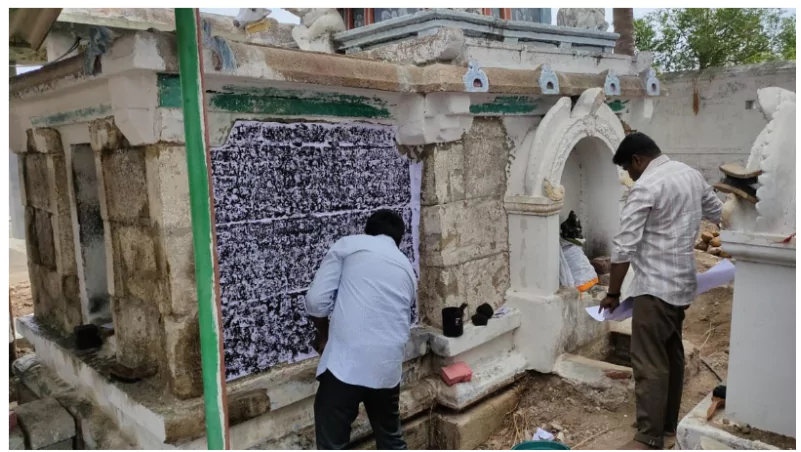Recently, a team of epigraphists from the Archaeological Survey of India (ASI), Mysore, embarked on an exercise to copy important stone inscriptions onto inked papers at the Thalishwarar temple in Kovilpalayam near Palladam, and a few other places in Tiruppur district.
- The team also recorded inscriptions from two hero stones, an Ayyanar sculpture, and a Nandi (bull) sculpture located a few kilometres from the temple.
Crucial Insights on the Embarking Exercise to Copy Stone Inscriptions onto Inked Papers
Thalishwarar temple is one of the ancient granite stone temples in the Kongu region. The inscriptions on the four walls of the shrine are dedicated to the presiding deity, Thaleekeeiswarar. The ASI has identified eight inscriptions inside the temple complex.
Enroll now for UPSC Online Course

- About Eight Inscriptions: One inscription was in Vattezhuthu, probably from the 9th century, and the other seven inscriptions, likely to be from the 12th century, were in Tamil.
- Vattezhuthu: A form of Tamil writing script that was prevalent from the 5th century AD to the 12th century AD.
- 12 lines of Vattezhuthu inscription on the Arthamandapam of Thalikiswarar shrine.
- It was deciphered by the eminent Indian historian Prof Y Subarayalu.
- Belong to: As per the inscription, the temple was built by the medieval Chera ruler Kokkandan Viranarayanan, who ruled the middle part of the Kongu region in the 9th century AD.
- It says that the temple built by Kokkandan Viranarayanan should be protected at any cost, and the entire hereditary of the person who damages it will severely suffer and perish.
- The Cheras ruled over parts of modern Kerala during Sangam period.
- Their capital was Vanji and their important seaports were Tondi and Musiri.
- The Chera kings were also known as “Keralaputas” (sons of Kerala).
- Methodology Used: The inscriptions from the walls of the temple were copied using the “estampage method”.
- Estampage is the method being used by the archaeologists to copy the characters and symbols from inscriptions. In this technique, an exact imitation of an inscription is obtained in an inked paper and then used for further analysis.
- Creating Awareness: Experts urged the people to alert the ASI if they come across any such rare inscriptions, as these engravings form the primary source of information for writing history.
- Experts also created awareness about epigraphy among students from Bharathiar University in Coimbatore.
Check Out UPSC CSE Books From PW Store
About Archaeological Survey of India (ASI)
The ASI under the Ministry of Culture, is the premier organisation for the archaeological research and protection of the cultural heritage of the nation.
- Mandate: It regulates all archaeological activities in the country as per the provisions of the Ancient Monuments and Archaeological Sites and Remains Act, 1958.
- It also regulates the Antiquities and Art Treasure Act, 1972.
About Epigraphy
Epigraphy is the study of written matter recorded on hard or durable material.
- It is the study of inscriptions, or epigraphs, as writing; it is the science of identifying graphemes, clarifying their meanings, classifying their uses according to dates and cultural contexts, and drawing conclusions about the writing and the writers.
|
![]() 5 Aug 2024
5 Aug 2024

